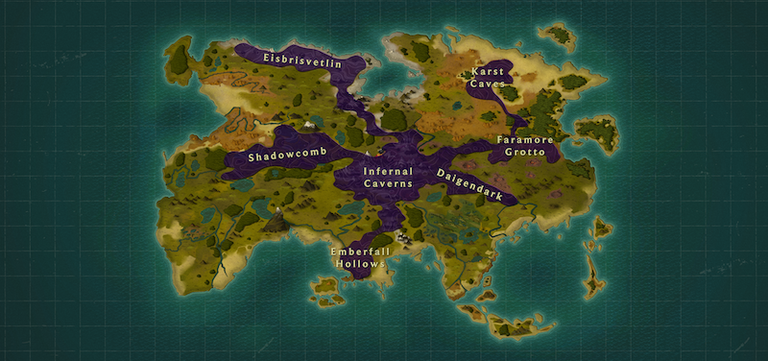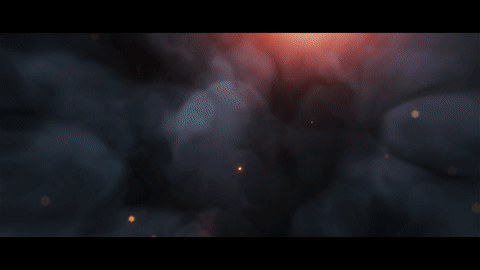

Overview
The Deep is a vast subterranean realm that sprawls beneath the Splinterlands. Shrouded in mystery and largely unexplored, its labyrinth of tunnels and caverns are believed to stretch beneath even the Colossus Ocean and Splinter and Primordic Seas.
Features
Daigendark (Shimmering Coasts)
The Daigendark comprises the network of passageways and caverns within and beneath the Daigenloft Mountains. It was formed through the dissolution of smaller limestone conduits by the natural acidity of groundwater. This concentrated the local flows of runoffs into larger solvent limestone layers interspersed within the mountain range’s caprock, creating the Daigendark’s massive cavern complexes.
The sandstone caprock of the Upper Daigendark, which includes the cave system above sea level and extends approximately four-hundred meters below the surface, contains fewer limestone deposits, making it more difficult for water to penetrate. Subsequently, it is relatively dry and lacking in speleothems.
However, the Lower Diagendark, which reaches an indeterminable depth, is composed of a greater proportion of limestone, and its caverns are resplendent with a large number of speleothems, including dripstone, flowstone, cave crystals, speleogens, and others.
Eisbrisvetlin (Pristine Northwest)
Eisbrisvetlin is a vast network of ice caverns beneath the Frigid Coasts formed through glacial movement and subglacial erosion. River, streams, and meltwater further contributed to the formation of the area’s cave system, sculpting an intricate, labyrinthine complex adorned with a myriad of frostwork and ice speleothems formed by a mixture of mineral deposits and ice, the refractive properties of which create a mesmerizing display of light and give the Eisbrisvetlin an otherworldly appearance.
Emberfall Hollows (Central Fire)
Emberfall Hollows is located beneath the Central Fire's Southern Highlands and is accessible through various entrances located in the depths of the Great Scar. It is characterized by its warm, mineral-rich springs and naturally heated pools, which have carved and shaped the surrounding rock over countless centuries. The walls of its cave system are a kaleidoscope of mineral deposits, painting the caverns in hues of ochre, rust, and gold.
Emberfall Hollow’s most breathtaking feature is Lake Kaelinith, a vast underground body of water fed by a massive waterfall that cascades from an opening in the cavern wall high above its surface. Lake Kaelinith’s waters are heated by geothermal vents that fill the cavern with a heavy mist.
Faramore Grotto (Great Lowlands)
Faramore Grotto is a cave system that lies beneath the arid expanse of the Wastes of the East. It was carved by subterranean rivers and etched by the same erosive forces that shaped the surface, which is reflected in its network of narrow, winding tunnels and vast, vaulted caverns. Its walls and diverse speleothems—ranging from delicate stalactites to grand columns—are a geological tapestry, showcasing a multitude of sedimentary rock layers that chronicle the eons.
Infernal Caverns (Central Fire)
The Infernal Caverns are located beneath the Agniavas. They are a massive cave system sculpted by volcanic activity and ancient, heat-hardened rock. Rivers of magma flow throw lava tubes and pool in massive lakes. Fumaroles and thermal vents emit steam and gasses, creating colorful mineral deposits and crystalline structures that cast vibrant reflections in its thermal pools. Rapidly cooling lava flows take shape as smooth yet sharp-edged obsidian formations or columnar basalt.
The rumblings of Mount Praetorous often reach deep into the Infernal Caverns, and the threat of cave-ins is always present. Combined with its extreme heat, these conditions create an environment capable of supporting only the most resilient species.
Karst Caves (Wild Northeast)
The Karst Caves are located in the Wild Northeast, beneath the Sea of Karsts. They were formed by the slow, relentless drip of acidic water through limestone, creating a cave complex that mirrors the limestone formations of their sister superterranean karsts. The caves are filled with a multitude of speleothems, the preponderance being enormous stalactites and stalagmites that often meeting to form columns, some as wide as a castle tower. Subterranean rivers and streams flow through the caverns in a network of natural canals, and the air is cool and damp, making the Karst Caves ideally suited for a wide array of subterranean life.
Shadowcomb (Broken Lands)
Beneath the Jagtooth Mountains and Broken Lands lies Shadowcomb, a sprawl of cathedral-like caverns and interconnecting caves and passageways. In its enormous chambers, the largest of which stretch over twenty kilometers in length, subterranean forests thrive.
The trees of Shadowcomb have developed a symbiotic relationship with the bioluminescent algae and fungi of the area, which emit a spectrum of light that allows for limited photosynthesis and casts the forests in a perpetual twilight. Additionally, Shadowcomb’s trees have also adapted to use a form of chemosynthesis, enabling their specialized root systems to efficiently absorb the nutrients from the mineral-rich subsoil.
Population
The Deep is primarily populated by dark dwarves, deep gnomes, onyx orcs, venari, dark elves, kobolds, khayals, shadites, mycelias, and arachnes. However, much of its network of caverns is unexplored, and the majority of its sovereignties and settlements remain a mystery.
The Daigendark is the most well charted feature of the Deep. The dark dwarven Kingdom of Duskforge is located in the Lower Daigendark, as is the Broken Earth Clan, one of the largest populations of venari in Praetoria. In the Upper Diagendark can be found the Argarux, a tribe of onyx orcs that also inhabit the western foothills of the Daigenloft Mountains; a colony of deep gnomes and grove of arboreal shadites, who have formed an alliance against the dangers of the Deep; the muriden hamlet of Meriput; and a variety of other species.
While the capital of Sskah Den, New Sskah City, is located primarily on the subsurface of the Wastes of the East, portions of its tunnels and caverns connect with Faramore Grotto.
The vast horde of the Mycelic Brood inhabits the Deep’s subterranean bowels. Its fungoids often venture through its upper reaches and to Praetoria’s surface in search of additional hosts to grow their ranks.
Daedoks
When the legions of Chaos opened their rifts and invaded the Splinterlands—and again when the Riftwatchers followed—it sent reverberations of magic into the earth, where they found resonance. The deeper they traveled, the greater their intensity grew until, in the nethermost portions of the Deep, it was so great that the ley lines separating the Splinterlands from the Lower Planes were torn asunder.
Daedoks—an obscenity of creatures born of nightmares—spilled forth. They swarmed through the lower dark, driven by a ravenous hunger and feasting upon any who fell within their path.
Most remain in the labyrinth of tunnels and caverns of the lower dark, near the rifts that lead to the Lower Planes and back to their homeland. They prefer darkness and the confines of caverns and loathe the open sky and scorching sun. But on occasion, a swarm of daedoks find their way through the upper dark to the surface. When they do, they do not stray far from the caves and crevices that lead back into their subterranean refuge.
But, oh, the sweet flesh of the overlanders is so very tempting.

Stay tuned for more updates from the Splinterlands!
Website | Blog | Discord | Telegram | Shop

NOTE: All rewards from this post will be sent to @sps.dao.
Curated and voted 100% by Selection of the best articles about Games and eSports in Hive.